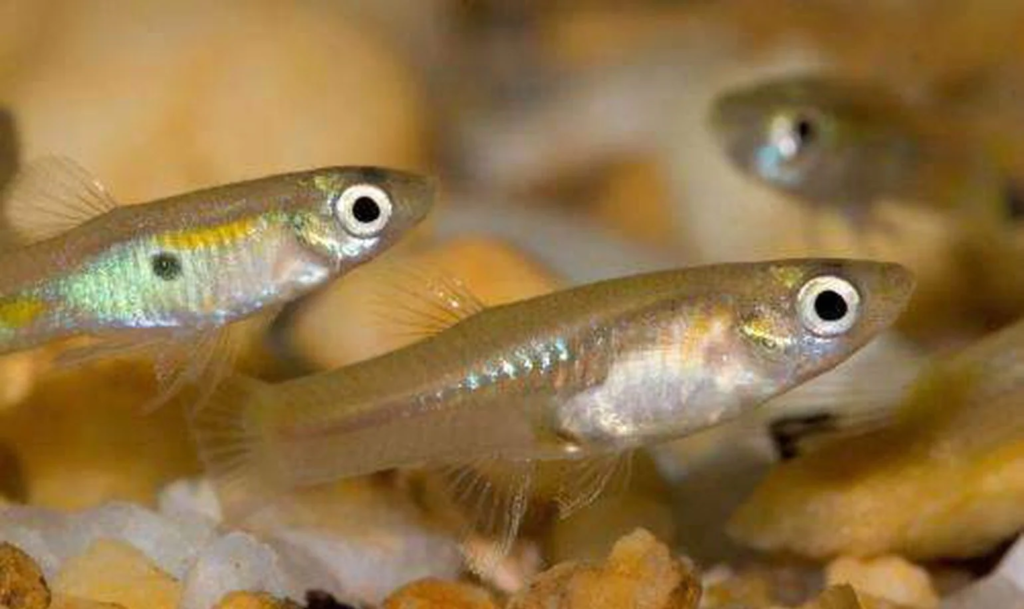Feeder guppies, also known as Poecilia reticulata, feeder fish or feeder guppy, are a popular choice as a feeder fish and serve multiple purposes in the fishkeeping hobby. These small, colorful fish are often used as live food for predatory fish, but they can also be kept as pets in their own right. In this guide, we’ll explore everything you need to know about feeder guppy, including their origin, tank setup, breeding, feeding, common diseases, and more.
What are Feeder Guppies?
Feeder guppies, scientifically known as Poecilia reticulata, are a specific strain or variation of guppies that have been selectively bred and raised primarily for use as live food for predatory aquarium fish. These guppies are not typically kept as pets but are instead to serve as a source of live prey for larger carnivorous fish, such as certain species of cichlids, pufferfish, and other piscivorous (fish-eating) fish.
Feeder guppy share their origins with their original native guppy, which are the colorful and popular guppy fish often kept as pets in aquariums. However, feeder guppies are specifically bred for their reproductive capacity, rapid growth, and resilience, making them an ideal choice for those who need live food to feed their carnivorous aquatic pets. These guppies reproduce prolifically, providing a continuous supply of live prey for the predator fish in the same tank. Source: Wikipedia
Origin of Feeder Guppies
Feeder guppies are native to northeastern South America, primarily in regions such as Venezuela, Trinidad, and Barbados. These hardy fish were introduced to the aquarium trade in the early 20th century and quickly gained popularity due to their vibrant colors and ease of care. While they are considered a separate strain bred specifically as food for larger fish, feeder guppies share their origins with their ornamental counterparts.

Tank Setup for Feeder Guppy
Tank Size:
Feeder guppy are small fish, typically reaching an adult size of 1.5 to 2 inches (3.8 to 5.1 cm). A small aquarium can be suitable for a colony of feeder guppies. A 10 to 20-gallon tank is adequate for a small group, while larger tanks can house more guppies. However, it’s important to provide enough horizontal swimming space, as they are active fish. How to Set Up a Guppy Fish Tank: The 10 Step Guide for Beginners on setting up a guppy fish tank
Water Parameters
Maintaining the right water conditions is essential for the health of your feeder guppies. Here are the ideal parameters:
| Parameter | Ideal Range |
|---|---|
| Temperature | 72-82°F (22-28°C) |
| pH | 6.5-7.5 |
| Hardness (dGH) | 5-15 dGH |
| Ammonia/Nitrites | 0 ppm |
| Nitrates | <20 ppm |
Ensure that you cycle your tank properly before introducing guppies, as they are sensitive to ammonia and nitrites.
Filtration and Aeration
Feeder guppies are relatively undemanding when it comes to filtration, but a simple sponge filter or a hang-on-back filter can help maintain water quality. Adequate aeration is also essential, as they thrive in well-oxygenated water.
Substrate and Decor
Use a fine gravel or sand substrate, which resembles their natural habitat. Guppies appreciate the presence of plants like Java Moss and Hornwort, providing hiding spots and areas for fry to find refuge.
Breeding Feeder Guppies
Feeder guppy are known for their prolific breeding, making them an excellent choice for those interested in witnessing the process of livebearing fish reproduction. Here’s how you can encourage breeding:
How to Breed Guppies: A Comprehensive Step By Step Guide
Male-to-Female Ratio
For successful breeding, maintain a higher ratio of females to males, typically two or three females for every male. This minimizes stress on females and reduces the chances of males harassing a single female.
Gestation and Birth
Guppies have a short gestation period of approximately 26 to 31 days. When a female is close to giving birth, she will display a gravid spot, a dark mark near her anal fin. You can also isolate pregnant females in a separate breeding tank to protect the fry from being eaten by adult fish.
Rearing Fry
Once the fry are born, it’s essential to provide them with a safe environment. A separate fry tank with gentle filtration and finely crushed flake food or specialized fry food will help them thrive.
Feeding Feeder Guppies
Natural Diet
In the wild, guppies primarily feed on small invertebrates, algae, and organic matter. To ensure their health and vibrant coloration, replicate their natural diet as closely as possible in captivity.
Commercial Fish Food
High-quality flake or pellet food formulated for tropical fish is a good staple diet for feeder guppies. Look for options with a balanced mix of protein and plant matter.
Supplementary Foods
To enhance their diet, offer occasional treats such as live or frozen foods like daphnia, brine shrimp, or mosquito larvae. These supplements provide essential nutrients and stimulate their natural foraging instincts.
Feeding Frequency
Feed your feeder guppies two to three times a day in small portions. Only provide what they can consume within a few minutes to prevent overfeeding, which can lead to water quality issues.
Common Diseases and Health Care
Common Ailments
Feeder guppies, like any other fish, are susceptible to certain diseases. Some common issues include:
- Ich (Ichthyophthirius multifiliis): White cysts or spots on the skin and gills are characteristic symptoms. Quarantine and treatment with an ich medication are essential.
- Fin Rot: Torn or frayed fins can indicate fin rot. Improved water quality and antibiotic treatments can aid in recovery.
- Dropsy: Swelling of the abdomen and scales standing on end are signs of dropsy. This is a severe condition, and isolated treatment is necessary.
Quarantine
Newly acquired guppies should be quarantined for a few weeks to prevent the introduction of diseases into your main tank. During quarantine, monitor their behavior and appearance for any signs of illness.
Regular Maintenance
Maintain good water quality by performing regular water changes and monitoring water parameters. Clean filters and ensure the tank is free of uneaten food and debris, which can contribute to poor water quality.
Where can you buy feeder guppies
Feeder guppies are typically available from a variety of sources, as they are primarily bred for the purpose of serving as live food for other aquarium fish. Here are some common places where you can buy feeder guppies:
- Local Fish Stores (LFS): Many local fish stores carry feeder guppies as they are a staple for customers with carnivorous or piscivorous fish. Visit your nearest fish store and inquire about their availability.
- Pet stores: Many pet stores, such as Petco and PetSmart, sell feeder guppies in bulk.
- Online Retailers: Numerous online aquarium supply retailers sell feeder guppies. You can browse different websites and order them for delivery to your home. Be sure to choose a reputable and established seller to ensure the quality and health of the feeder guppies.
- Aquarists and Hobbyists: Some aquarium enthusiasts and hobbyists may breed their own feeder guppies and offer them for sale locally or online through forums, classified ads, or social media groups. This can be a more personalized and potentially cost-effective option.
- Pet Shows and Expos: If there are any local aquarium or pet expos or shows in your area, you may find vendors selling feeder guppies. These events are also an excellent opportunity to connect with other fish enthusiasts and gather information.
- Fish Farms: Some fish farms specialize in breeding and selling feeder fish, including feeder guppies. These farms may supply local fish stores and online retailers.
Once you have purchased feeder guppies, it is important to quarantine them for at least two weeks before adding them to your aquarium. This will help to prevent the spread of any parasites or diseases.
When purchasing feeder guppies, it’s important to ensure that they are healthy and disease-free, as the health of your predator fish relies on the quality of the live food you provide. Look for feeder guppies that appear active, vibrant, and free from any visible signs of illness. Additionally, consider the quantity you need and whether you can establish a breeding program to maintain a consistent supply over time.
How much do feeder guppies cost?
The cost of feeder guppy fish varies depending on the location and retailer. However, they are generally very inexpensive, costing between $0.25 and $1.00 per fish. Feeder guppies are often sold in bulk, such as 25 or 50 fish per bag.
It is important to note that feeder guppies are not typically bred or raised for the pet trade. They are often culls, or fish that have been rejected for breeding purposes. As a result, they may not be as healthy or hardy as pet guppies.
Additionally, feeder guppies are often raised in poor conditions and may be exposed to parasites or diseases. It is important to quarantine feeder guppies before adding them to your aquarium, and to monitor them closely for any signs of illness.
Despite their lower price tag, it is important to weigh the risks and benefits of using feeder guppies before buying them. If you are looking for healthy and hardy guppies to keep as pets, it is best to purchase them from a reputable retailer.
Here are some tips for buying feeder guppies:
- Avoid buying feeder guppies that are lethargic, have sunken eyes, or have any visible injuries or parasites.
- Ask the retailer about the fish’s source and how they were raised.
- Quarantine feeder guppies for at least two weeks before adding them to your aquarium.
- Monitor feeder guppies closely for any signs of illness.
If you are unsure whether or not feeder guppies are right for you, it is always best to consult with an experienced fishkeeper.
Conclusion
Feeder guppies can be a captivating addition to your aquarium, whether you’re using them as live food for larger fish or simply enjoying their vibrant colors and active nature. By providing a suitable tank setup, understanding their breeding habits, offering a balanced diet, and practicing proper health care, you can ensure the well-being of your feeder guppies. Keep in mind that these small fish can offer a great learning experience for beginner aquarists, as they exhibit fascinating behaviors and reproductive strategies.










